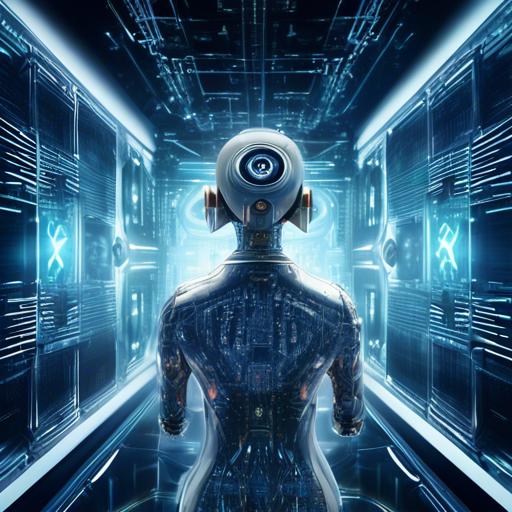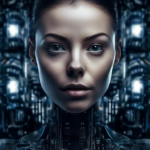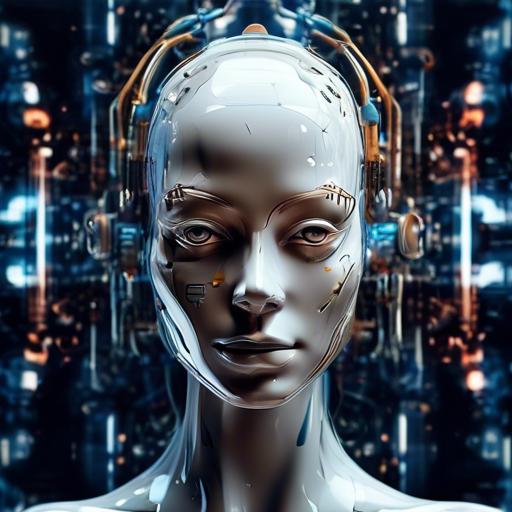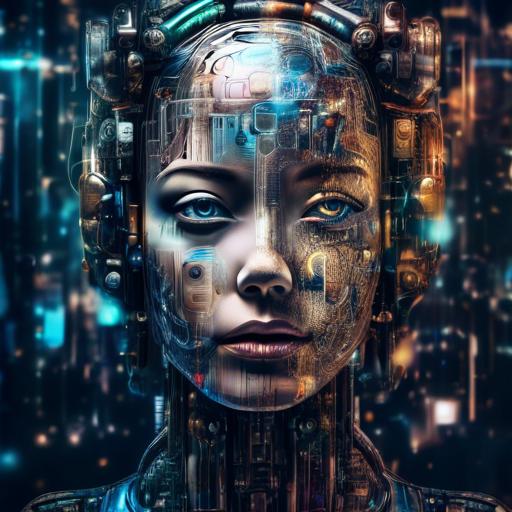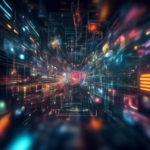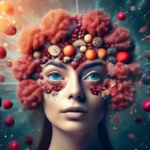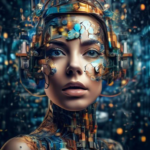Imagine this: a world where your imagination is the only limit, where artists and non-artists alike can summon breathtaking landscapes, lifelike portraits, and surreal dreamscapes with just a click. A world where the boundaries between human creativity and machine ingenuity blur into a seamless tapestry of innovation. Welcome to the frontier of AI image generation technologies—a realm where pixels transform into poetry, and the future of visual art is reshaped before our very eyes.
In this dynamic landscape, the brushstrokes of algorithms and neural networks are painting a new narrative for the artistic community and beyond. From hyper-realistic renderings that challenge our perception of reality to avant-garde compositions that redefine aesthetic norms, AI-driven image generation is not just a technological marvel; it is a partner in creativity, an enabler of new perspectives, and a muse for the modern age.
Join us as we explore the future trends that are poised to revolutionize how we create, interpret, and interact with imagery. Whether you’re a seasoned artist, a tech enthusiast, or simply curious about the marvels of AI, this journey promises to illuminate the exciting possibilities that lie ahead. The future of art is here, and it’s more colorful and innovative than ever before.
Table of Contents
- Advancements in Neural Network Architectures
- The Role of Generative Adversarial Networks in Image Creation
- Ethics and Responsibility in AI-Generated Imagery
- Unleashing Creativity with AI: Collaboration between Artists and Machines
- Integrating AI Image Generation into Commercial Applications
- Overcoming Challenges in AI Image Accuracy and Realism
- Future-proofing AI: Ensuring Scalability and Adaptability
- The Conclusion
Advancements in Neural Network Architectures
The field of neural networks is evolving at a breakneck pace, unlocking new potentials in AI-driven image generation. One of the most notable breakthroughs involves the development of **Generative Adversarial Networks (GANs)**. These architectures pit two neural networks against each other: a generator, which creates images, and a discriminator, which evaluates them. This adversarial process results in highly realistic images that continually improve as training progresses.
Recent advancements in **Transformer-based architectures** have also made significant impacts. Originally designed for natural language processing, transformers like the Vision Transformer (ViT) have shown exceptional performance in image generation tasks. These models can handle larger image contexts and dependencies more effectively than traditional convolutional networks.
In addition to these advancements, there is a growing focus on **Neural Architecture Search (NAS)**. This innovative approach automates the design of neural network topologies, reducing the trial-and-error aspect of model development. By leveraging NAS, researchers can identify optimal architectures for specific image generation tasks, leading to more efficient and effective models.
Moreover, the integration of **self-supervised learning techniques** has shown promise in improving image generation capabilities. By training models on vast amounts of unlabelled data, these techniques help neural networks learn nuanced features and patterns, resulting in more detailed and accurate images.
Key include:
- **Adversarial Training**: Enhances realism and detail in generated images.
- **Transformer Models**: Improved contextual understanding and handling of image data.
- **Automated Neural Architecture Search**: Streamlines model development and optimization.
- **Self-Supervised Learning**: Enables models to leverage unlabelled data effectively.
| Architecture | Key Feature | Impact |
|---|---|---|
| GANs | Adversarial Training | High Realism |
| Transformer Models | Context Handling | Improved Detail |
| NAS | Automated Search | Optimal Design |
| Self-Supervised Learning | Unlabelled Data Training | Detail Accuracy |
The Role of Generative Adversarial Networks in Image Creation
Generative Adversarial Networks (GANs) have revolutionized the field of image creation by enabling machines to produce highly realistic images from scratch. At the core, GANs consist of two neural networks, the **generator** and the **discriminator**, which engage in a dynamic, competitive process. The generator crafts images from random noise, while the discriminator evaluates their authenticity, identifying which images are fake and which resemble the training data. This tug-of-war continues until the generator produces images that the discriminator can no longer discern from real ones.
The impact of GANs extends beyond mere image generation; they have facilitated innovations in various creative and commercial applications. Examples include:
- **Art Creation**: Artists and hobbyists use GANs to generate unique paintings, sculptures, and even digital video art.
- **Fashion Design**: Designers employ GAN-generated models to visualize and prototype clothing concepts.
- **Content Augmentation**: GANs assist in augmenting existing content for movies, video games, and virtual reality environments.
When it comes to the creation process, GANs have transcended the traditional boundaries of creativity. Here’s a look at the stages and tasks facilitated by these networks:
| Stage | Task |
|---|---|
| Data Preprocessing | Cleaning and formatting training data. |
| Training | Iterative optimization of the generator and discriminator. |
| Image Generation | Creating new, visually convincing images. |
| Validation | Discriminator verifies the authenticity of generated images. |
Furthermore, GANs are increasingly integrated with other technologies to enhance their capabilities. **StyleGAN**, for instance, allows for intricate control over the generated images’ style and structure, opening the door to tailor-made content production. Likewise, **CycleGAN** enables style transfer between images, facilitating the conversion of photographs into artistic renditions or vice versa. These advances highlight the versatility and potential of GANs to address diverse creative and practical needs.
Ethics and Responsibility in AI-Generated Imagery
As AI-generated imagery continues to evolve, significant ethical considerations and responsibilities arise. One fundamental concern is the potential misuse of AI tools to create deceptive or manipulative content. **Deepfakes** are a prime example, where AI-generated videos can fabricate events or impersonate individuals with striking realism. This poses risks to privacy, consent, and the integrity of information. Ensuring that AI-generated imagery adheres to ethical standards involves rigorous guidelines and transparency in how these tools are developed and deployed.
Another crucial aspect is intellectual property rights. With AI systems capable of producing original artwork or designs, questions emerge regarding ownership and credit. Does the AI creator hold the rights, or does the person who programmed it? Here’s a comparison table to illustrate:
| Scenario | Ownership |
|---|---|
| Human artist using AI tools | Human artist |
| AI-generated artwork without human intervention | Undefined, subject to legal interpretation |
| Commissioned AI art project | Commissioning party, unless otherwise agreed |
Moreover, there’s a conversation to be had about **bias** and representation in AI-generated images. AI systems learn from vast datasets that may contain historical and cultural biases. This can result in imagery that perpetuates stereotypes or unfair portrayals of certain groups. To mitigate this, developers must prioritize diversity in training data and continually scrutinize AI outputs for inadvertent biases. Inclusive representation is not just a technical challenge but a moral imperative.
Users and developers of AI imagery technologies must commit to **responsibility and accountability**. Adopting a code of ethics, engaging in transparent practices, and establishing clear consent protocols are steps toward responsible use. Encouraging wide-ranging discussions within the tech community and beyond will also foster a culture of ethical AI development. As AI continues to shape the visual landscape, maintaining ethical integrity will be key to its positive impact on society.
- Transparency in AI development – Clear documentation and disclosures about AI models.
- Bias mitigation – Ensuring diverse and inclusive training datasets.
- Ownership clarity – Defining intellectual property rights for AI-generated content.
- Ethical guidelines - Establishing and adhering to a code of conduct for AI usage.
Unleashing Creativity with AI: Collaboration between Artists and Machines
Imagine a world where the brushstrokes of a painter blend seamlessly with the precision of an algorithm. This is no longer just a fantasy but a reality being crafted through the collaboration between artists and AI. **Artificial Intelligence Artistry** isn’t about replacing the human touch; rather, it’s about enhancing creative capabilities and pushing the boundaries of what’s possible.
One of the most fascinating aspects of this collaboration is the way artists utilize AI tools to generate new artistic styles and compositions. **Artists and AI collaborate in various ways:**
- **Style Transfer**: Transforming photographs into the style of famous painters like Van Gogh or Picasso.
- **Generative Adversarial Networks (GANs)**: Creating entirely new and unique pieces of art that resemble nothing seen before.
- **Interactive Art Installations**: Engaging viewers in real-time, ever-changing artwork developed through machine learning.
| Technique | Description | Use Case |
|---|---|---|
| Style Transfer | Applying the stylistic elements of one image to another. | Photographs turned into famous artworks |
| GANs | Generating new images from a mix of existing ones. | Novel art pieces |
| Interactive Art | Engaging real-time art creation with user inputs. | Dynamic installations |
By collaborating with AI, artists are finding new pathways to self-expression while exploring uncharted territories. **Imagine traditional artists integrating AI to refine texture and color** more precisely than ever before or digital artists leveraging AI to produce intricate designs at the click of a button. These tools are not just practical; they are deeply inspiring, allowing artists to envision and create what was previously unimaginable.
Perhaps the most exciting trend is the democratization of art through AI. With AI-powered tools, even those without formal training can explore and create art, broadening the accessibility of artistic innovation. By reducing the barriers to entry, AI fosters a more inclusive creative environment where diverse voices and visions can flourish.
As this symbiotic relationship between human creativity and machine precision continues to evolve, the future of art looks poised to be more vibrant and imaginative than ever. Artists working hand-in-hand with AI are not just creating art; they are shaping the future of the creative world, weaving together the best of both human intuition and artificial intelligence.
Integrating AI Image Generation into Commercial Applications
- Incorporating AI image generation tools within commercial platforms can radically enhance user experiences, driving engagement and innovation.
- From e-commerce to virtual reality, the applications are vast and evolving at an extraordinary pace.
Retail and E-commerce
Imagine shopping for clothes online and having an AI generate hyper-realistic images of you wearing different outfits, tailored to your exact body measurements and skin tone. Retailers can utilize AI generated images to showcase products in a variety of settings and lighting conditions, giving customers a more immersive shopping experience without ever leaving their homes.
Benefits at a Glance
| Benefit | Description |
|---|---|
| Cost Efficiency | Reduces the need for expensive photoshoots and model fees. |
| Customization | Offers endless possibilities for personalized visual content. |
| Scalability | Creates large volumes of images rapidly, meeting high demands. |
Entertainment and Media
Movie studios and gaming companies are exploring AI-generated imagery to create fantastical worlds and lifelike characters, reducing reliance on traditional CGI techniques. AI can instantly generate countless variations of a scene or character, helping artists and directors fine-tune their visions with unprecedented flexibility and speed.
Marketing and Advertising
For marketers, AI image generation opens up new realms for creating captivating visual content that resonates more deeply with audiences. Personalized ad campaigns can be crafted to fit individual customer preferences, all driven by sophisticated AI algorithms. By tapping into these capabilities, brands can significantly boost their outreach and conversion rates, making their campaigns more dynamic and adaptive.
The transformation brought by AI image generation is not just an incremental improvement, but a seismic shift in how visual content is conceived and delivered. As technology continues to advance, businesses that integrate these innovations will be uniquely positioned to lead in an increasingly competitive marketplace.
Overcoming Challenges in AI Image Accuracy and Realism
The road to achieving pinpoint accuracy and lifelike realism in AI-generated images is riddled with numerous challenges. Central to this is the difficulty in creating datasets that are both extensive and diverse enough to train AI models effectively. Many times, biases in datasets lead to images that unintentionally perpetuate stereotypes or omit entire segments of the population. Ensuring a wide-ranging dataset requires relentless effort and innovative data collection techniques.
Another key issue lies in the sheer complexity of real-world details. To address this, researchers are pushing the boundaries with advanced algorithms like Generative Adversarial Networks (GANs), but even these cutting-edge models can struggle. For instance, fine textures such as hair, individual leaves on a tree, or intricate architectural details pose significant hurdles. These elements are notoriously difficult to replicate with high fidelity.
Key Approaches Being Explored:
- **Adversarial Training**: Utilizing a dual-model setup where one generates images and the other critiques them, pushing both towards improvement.
- **Transfer Learning**: Leveraging pre-trained models on similar tasks to enhance performance on new, but related, challenges.
- **Style Transfer**: Incorporating techniques that blend the stylistic elements from one image into another to create more visually appealing results.
In dealing with color accuracy and natural lighting, AI models often fall short. Simulating the myriad ways light interacts with surfaces in different environmental conditions is incredibly complex. Many methodologies, like ray tracing, have been adopted from traditional graphics rendering techniques to combat this issue. While promising, these approaches still require immense computational power and sophisticated algorithms.
Here’s a quick comparison of current AI image generation technologies:
| Technology | Strengths | Weaknesses |
|---|---|---|
| GANs | High-quality images, creativity | Require large datasets, computationally heavy |
| Neural Style Transfer | Artistic, visually appealing | Limited realism, style consistency |
| VAEs (Variational Autoencoders) | Good at encoding data, semi-supervised learning | Lower image quality, blurriness |
It’s critical to foster an environment where these technologies can continue to evolve. Open-source collaboration, shared datasets, and robust ethical guidelines will be cornerstone elements in overcoming these challenges. As experts and enthusiasts in the field, we must remain vigilant and innovative, driving the next wave of advancements in AI image generation.
Future-proofing AI: Ensuring Scalability and Adaptability
As we look towards the future, one of the paramount concerns for AI image generation technologies is their ability to scale efficiently and adapt to dynamic environments. Stability and flexibility are crucial in ensuring these systems meet growing demands and diverse application needs.
**Key strategies to enhance scalability include:**
- **Modular Frameworks**: Designing AI systems with modular architectures allows for incremental upgrades and replacements without overhauling the entire system.
- **Cloud Integration**: Leveraging cloud platforms for storage and processing can facilitate real-time scalability and responsiveness across different geographies.
- **Efficient Algorithms**: Implementing advanced algorithms that optimize resource use, such as reducing computational overhead, can significantly improve performance.
**Adaptability** is equally critical. As the landscape of AI image generation evolves, systems must seamlessly integrate new data types, models, and processing requirements. Here’s how:
- **Continuous Learning:** Incorporate mechanisms for continuous learning and self-improvement to stay current with new patterns and data variations.
- **Interoperability:** Ensure that AI frameworks and tools can interoperate with diverse systems and applications.
- **Customizability:** Provide user-friendly interfaces for customizing parameters and outputs to meet specific user needs and preferences.
Let’s visualize these concepts with a concise comparison:
| Aspect | Scalability | Adaptability |
|---|---|---|
| Design Strategy | Modular Frameworks | Continuous Learning |
| Resource Management | Cloud Integration | Interoperability |
| Performance Optimization | Efficient Algorithms | Customizability |
By embedding these principles, developers can ensure that AI image generation technologies are not only effective today but also robust enough to meet the unknown challenges and opportunities of tomorrow.
The Conclusion
As we journey into the future of AI image generation technologies, the possibilities seem endless. With advancements in machine learning and neural networks, we are witnessing a revolution in how images are created and perceived. The seamless blending of art and technology is pushing boundaries and unlocking new creative potentials.
As we embrace these future trends, let us remember to harness this power responsibly and ethically. Let us continue to push the boundaries of what is possible while always keeping in mind the impact on society and humanity. The future of AI image generation is bright, and with our innovative spirit, we can shape a world where art and technology harmoniously coexist.
So, let’s embark on this exciting journey together and see where the future takes us. The possibilities are boundless, and the future is ours to create. Let’s embrace these future trends in AI image generation technologies with open minds and hearts, and watch as our imaginations come to life in ways we never thought possible. The future is now, and it’s filled with endless possibilities. Let’s create a brighter, more beautiful world together.

